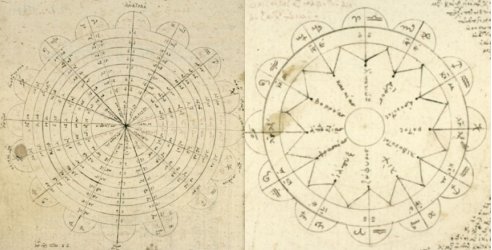Rene Zandbergen recently stumbled upon a circular drawing in the Bibliotheque Nationale de France’s MS Coislin 338, and wondered whether it might be “a possible precedent for a Voynich astronomical illustration, where the original MS is Greek“, just as for two other Greek manuscripts (Codex Taurinensis C VII 15 and MS Vat Gr. 1291) he turned up and wrote about in other years. What he finds interesting is that “the Voynich MS astronomical illustrations are rather arcane, and do not deal at all with the astronomy of the times of Copernicus and after, but with the times much before that.”
To my eyes, though, comparing just one page of MS Coislin 338 with the thrice-great APOD picture isn’t the whole story. You see, a fair few years ago Voynich researcher John Grove proposed that the VMs’ Quire 9 had been misbound along an incorrect fold after the quire numbers had been added but before the folio numbers were added: and if you follow his argument through, you discover that without much doubt the VMs originally placed its 16-way “sun-face” page f68v1 immediately adjacent to its 12-way “moon-face” (APOD) page f67r1.
This elegant (but still fairly basic) codicological observation is why I find the APOD comments (for each of the three times the picture on the right has come up) lacking, because nearly all of them were made without grasping these two pages’ original context. OK, so far so “Curse of the Voynich” (pp.58-61, to be precise) – and I would add that it seems fairly unlikely to me that the two (very different) blue paints on these pages were added when they were in their original page order. But what is new for 2010 is that MS Coislin 338 also contains a 16-way circular diagram (fol. 121v) placed immediately adjacent to Rene’s 12-way circular diagram (fol. 122r). And the zigzag edging on the two right-hand 12-way drawings seems eerily familiar too…
So… you might reasonably ask what amazing secrets this section of MS Coislin 338 holds: but if you did, you’d perhaps be a little disappointed to find out that it simply contains a Greek commentary by Theon of Alexandria (Hypatia’s father, as historical proto-feminist conspiracy fans may already know) on Ptolemy’s Handy Tables. Intriguingly, this particular copy was made in the 15th century – but that may (for the moment) be just about as far as we can take this whole parallel.
The problem we face is that we simply don’t know whether such irritatingly good matches between documents are causal, correlative, or (given the large number of documents that have been trawled over the years for comparison) simply random. Really, it would take someone sitting down with a proper critical edition of Theon’s commentary around these pages to see what kind of data it describes, and then prolonged meditation on what we might think about the Voynich Manuscript’s possibly-linked pages as a result. But is anyone likely to do that? I’m not sure… but perhaps we’ll see!

